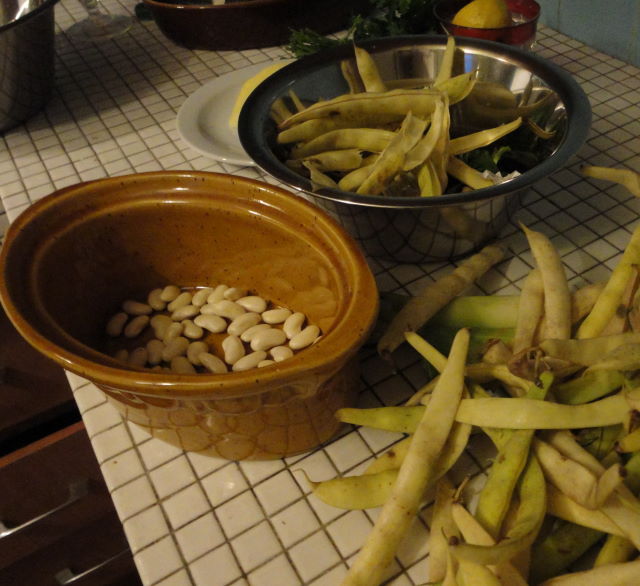
The region of the Béarn in the Pyrenees Atlantique has a rich culinary tradition, one that it shares in part with its neighbors. To the north is Gascony, with its love all things duck, including the use of duck fat, confits and foie gras. To the south and west are the Pays Basques, famous for hams, peppers , its bountiful use of seafood and of course Gateau Basque, which is found throughout southwestern France. To the east is the region of the Gers, with its capitol in Toulouse, famous for cassoulet and white beans (the white beans from Tarbes, just east of Pau are sometimes cited as the white bean to use when making authentic cassoulet while others argue that it is the haricot coco) .
The Béarn shares in all of these traditions to some extents, but manages to find a unique identity of its own. It is a cuisine rich in duck, pork and game, but it also leans heavily toward cabbage, root vegetables, chestnuts, mushrooms and prunes. River fish (salmon and trout) from the Gaves of Béarn are famous and the cuisine makes liberal use of ocean fish from the nearby Bay of Biscay (tuna, salmon, anchovies, sardines, mackerel, and sea bass).

The classic dishes of Béarnais cooking can still be found in many restaurants throughout the region; Poule au pot (chicken boiled with vegetables); Tourtiere aux pommes (a sort of flakey apple tart, usually served warm), Confit de porc (pork shoulder slow cooked in fat and served with potatoes).
The most ubiquitous dish of the Béarn, however is garbure, a dish whose origins are often attributed to Gascony. Garbure in its original inception is a peasant dish, a soup of white beans, cabbage and root vegetables long simmered over a low heat, preferably in the corner of the hearth in an earthenware pot. Other ingredients were sometimes included to add richness, depending on the affluence of the household. Ventreche (cured pork belly, similar to panchetta), ham ends, sausages, and duck confit all are common items in the garbure of a cook with a more liberally stocked larder. Today, you can find everything from all vegetable garbure in simple restaurants to opulently rich versions in starred temples of Southwest gastronomy. In many ways it’s a similar story to cassoulet; a peasant dish that has, over time, evolved into central pillar of its region’s culinary tradition at levels modest and elevated.
At the Hotel-Restaurant Terminus, a family style restaurant with 8 rooms upstairs across from the trains station in Orthez, they still observe the tradition of serving soup as the beginning of every meal (a tradition that has disappeared in most Parisian restaurant but still can be found in the countryside). Everyday, that soup is garbure in its simplest form; cabbage, carrots, white beans and onions simmered with thyme and bay without stock, using water instead. The resulting light soup is enriched before serving with a spoonful of duck fat and is served a volontiers (meaning they put the tureen on the table and you serve yourself to as much as you like, remembering that there is still a starter, main course and dessert or cheese to come).

On the other hand, the garbure at the Ferme-Auberge “Marquine”, near Montfort-en-Chalosse, was a rich, long simmered affair made with pork belly, duck gizzards and duck neck. As the name implies, this rustic restaurant, run by Jessica and Jean-Michel Cabannes, is a working farm with a few rooms and a small dining room that welcomes people who are traveling through the region or who are seeking an authentic connection with farm life. Much of the food they serve, including all the duck, goose and pork, is raised on the farm. Madame Cabannes recipe, for garbure sounds very simple and contains no measurements at all. All the same, it yields a thick, flavorful soup that is has more in common with cassoulet than vegetable soup. It is offered as a first course but could easily serve as a meal.

Armed with a number of experiences in eating garbure and a ready supply of fresh white beans (October is the season for them in the Béarn), I decided to try my hand at making this classic dish. For vegetables, in addition to white beans, I followed Madame Cabannes’ advice; I took whatever vegetables I had at hand, namely carrots, leeks, onions, garlic and some thyme. As for meat, I selected ventreche and a confited duck neck that I had purchased at the farmers market at Amou (note: 1 confit duck neck = 1 euro) the day before.

Four hours (and honestly not a lot of work) later, my garbure was finished. The results were gratifying and rich enough to serve as the center of the meal with just crusty bread and a green salad.
On a side note, one of the most famous dishes from Béarn, sauce Béarnaise, doesn’t come from the Béarn at all, but from Paris. Culinary legend has it that sauce Béarnaise was invented in the 1830’s by the chef of a Paris restaurant called Restaurant Henri IV. Evidently, the name for sauce came from the connection between Henri IV and the Béarn, where he was born. (I for one always assumed that Sauce Béarnaise was developed by Escoffier, like so many of the elements of modern French cooking…this is apparently incorrect as well).
now I have to spend all day looking for a confited duck neck – think I’m SOL in Seattle